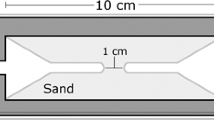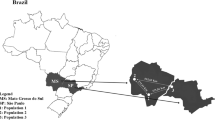Abstract
Cuticular hydrocarbon patterns of the Formosan subterranean termite, Coptotermes formosanus Shiraki, were similar among colonies from the same geographical location. Hydrocarbon patterns of Florida colonies were easily distinguished from those of Hawaii colonies by using canonical discriminant analysis. Groups of termites from the same colony did not fight one another when placed in an arena. Intercolonial aggression was not recorded among C. formosanuspopulations from Florida but three colonies from Hawaii fought with the other Hawaiian and three Florida colonies. Of the 12 colonies (six each from Florida and Hawaii) tested, 3 Florida colonies did not direct or receive aggression from any other colony. Cuticular hydrocarbon patterns were not correlated with agonistic behavior.
Similar content being viewed by others
References
Adams, E. S., and Levings, S. C. (1987). Territory size and population limits in mangrove termites.J. Anim. Ecol. 56: 1069–1081.
Binder, B. F. (1988). Intercolonial aggression in the subterranean termiteHeterotermes aureus (Isoptera: Rhinotermitidae).Psyche 95: 123–137.
Blomquist, G. J., Howard, R. W., and McDaniel, C. A. (1979). Structure of the cuticular hydrocarbons of the termiteZootermopsis angusticollis (Hagen).Insect Biochem. 9: 371–374.
Clément, J. L. (1986). Open and closed societies inReticulitermes termites (Isoptera, Rhinotermitidae): Geographic and seasonal variation.Sociobiology 11: 311–323.
Haverty, M. I., and Thorne, B. L. (1989). Agonistic behavior correlated with hydrocarbon phenotypes in dampwood termites,Zootermopsis (Isoptera: Termopsidae).J. Insect Behav. 2: 523–543.
Haverty, M. I., Nelson, L. J., and Page, M. (1990). Cuticular hydrocarbons of four populations ofCoptotermes formosanus Shiraki in the United States: Similarities and origin of introductions.J. Chem. Ecol. 16: 1635–1647.
Howard, R. W., and Blomquist, G. J. (1982). Chemical ecology and biochemistry of insect hydrocarbons.Annu. Rev. Entomol. 27: 149–172.
Howard, R. W., McDaniel, C. A., and Blomquist, G. J. (1980). Chemical mimicry as an integrating mechanism: Cuticular hydrocarbons of a termitophile and its host.Science 210: 431–433.
Howard, R. W., McDaniel, C. A., Nelson, R. N., Blomquist, G. J., Gelbaum, L. T., and Zalkow, L. H. (1982). Cuticular hydrocarbons ofReticulitermes virginicus (Banks) and their role as potential species- and caste-recognition cues.J. Chem. Ecol. 8: 1227–1239.
Jones, S. C. (1987).Foraging Party and Territory Size of the Desert Subterranean Termite Heterotermes aureus(Snyder) in a Sonoran Desert Grassland, Ph.D. thesis, Univesity of Arizona, Tucson.
Levings, S. C., and Adams, E. S. (1984) Intra- and interspecific territory inNasutitermes (Isoptera: Termitidae) in a Panamanian mangrove forest.J. Anim. Ecol. 53: 705–714.
Nel, J. J. C. (1968). Aggressive behavior of the harvester termitesHodotermes mossambicus (Hagen) andTrinervitermes trinervoides (Sjöstedt).Insectes Soc. 15: 145–156.
Page, M., Nelson, L. J., Haverty, M. I., and Blomquist, G. J. (1990). Cuticular hydrocarbons of eight species of North American cone beetles,Conophthorus Hopkins.J. Chem. Ecol. 16: 1173–1198.
Pearce, M. J., Cowie, R. H., Pack, A. S., and Reavey, D. (1990). Intra-specific aggression, colony identity and foraging distances in SudaneseMacrotermes spp. (Isoptera: Termitidae: Macrotermitinae).Ecol. Entomol. 15: 71–77.
SAS Institute, Inc. (1985).SAS User's Guide: Statistics, version 5 ed., SAS Institute, Cary, N.C.
Su, N.-Y., and Scheffrahn, R. H. (1986). A method to access, trap, and monitor field populations of the Formosan subterranean termite (Isoptera: Rhinotermitidae) in the urban environment.Sociobiology 12: 299–304.
Su, N.-Y., and Scheffrahn, R. H. (1988). Intra- and interspecific competition of the Formosan and eastern subterranean termite: Evidence from field observations (Isoptera: Rhinotermitidae).Sociobiology 14: 157–164.
Su, N.-Y., Scheffrahn, R. H., and Ban, P. M. (1988). Retention time and toxicity of a dye marker, Sudan Red 7B, on Formosan and eastern subterranean termites (Isoptera: Rhinotermitidae).J. Entomol. Sci. 23: 235–239.
Swezey, O. H. (1914). Note and exhibitions.Proc. Hawaii. Entomol. Soc. 3: 27.
Tamashiro, M., Fujii, J. K., and Lai, P. Y. (1973). A simple method to observe, trap, and prepare large numbers of subterranean termites for laboratory and field experiments.Environ. Entomol. 2: 721–722.
Tamashiro, M., Yates, J. R., and Ebesu, R. H. (1987). The Formosan subterranean termite in Hawaii: Problems and control. In Tamashiro, M. and Su, N.-Y. (eds.),Biology and Control of the Formosan Subterranean Termite, Res. Ext. Ser. 083, University of Hawaii, Honolulu, pp. 15–22.
Thorne, B. L. (1982). Termite-termite interactions: Workers as an agonistic caste.Psyche 89: 133–150.
Author information
Authors and Affiliations
Rights and permissions
About this article
Cite this article
Su, N.Y., Haverty, M.I. Agonistic behavior among colonies of the Formosan subterranean termite,Coptotermes formosanus Shiraki (Isoptera: Rhinotermitidae), from Florida and Hawaii: Lack of correlation with cuticular hydrocarbon composition. J Insect Behav 4, 115–128 (1991). https://doi.org/10.1007/BF01092555
Accepted:
Issue Date:
DOI: https://doi.org/10.1007/BF01092555




